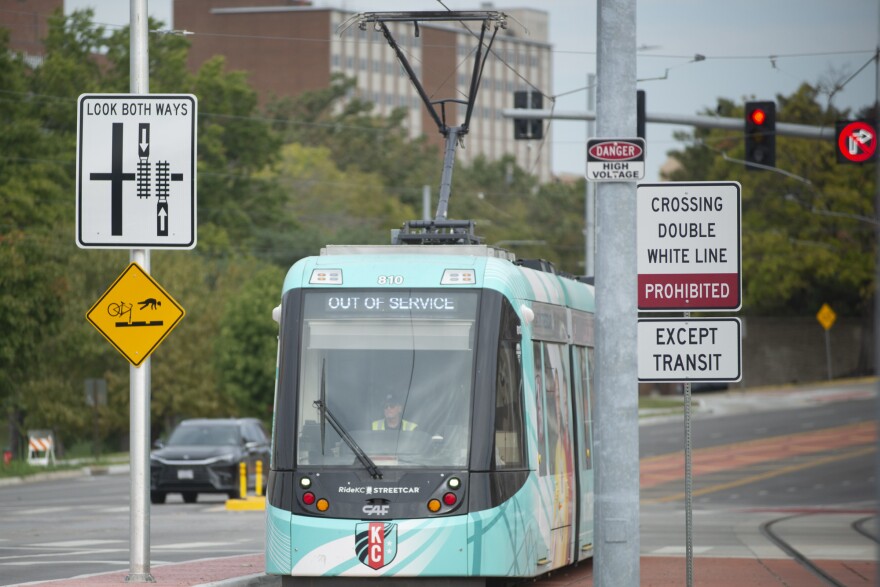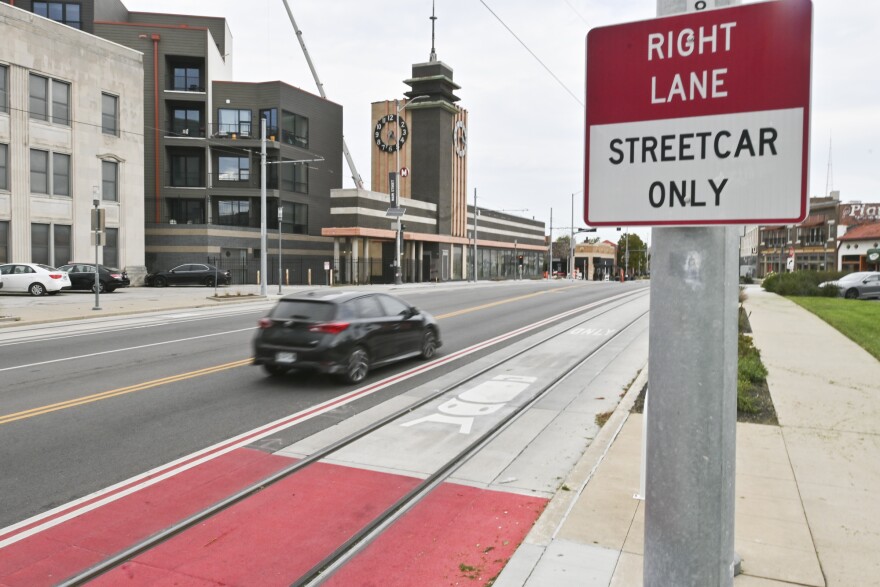The Kansas City Streetcar’s Main Street extension will open on Friday after more than three years of construction. This means people can get from the River Market to the Plaza area using rail for the first time since the city tore up its streetcar network in the 1950s.
It also means new rules for drivers.
The construction cones that went up in 2022 are gone, but now drivers will have to contend with a new obstacle: transit-only lanes. These lanes help the streetcar move more efficiently and drivers get around more safely, said Donna Mandelbaum, communications director for the KC Streetcar Authority.
“South of Pershing Road, Main Street used to be a six-lane road,” Mandelbaum said. “We have narrowed it down to four lanes: a streetcar-only lane, a car lane and then the turn lane in certain areas.”

The transit-only lanes run both directions on Main Street for the entire length of the extension — from Pershing Road, near Union Station, to 51st Street, near the University of Missouri-Kansas City. There are no transit-only lanes on Main in the downtown area.
The city has other transit-only lanes on Oak Street, north of 10th Street and on 12th Street near the East Village Transit Center downtown. But the new lanes on Main are by far the longest.
The easiest rule of thumb for navigating Main Street is to not drive in the right line unless you need to park or turn right. Different markings in these lanes denote they’re solely for public transportation.
“I think our regular drivers are like, ‘This is great. Now I have my lane, the streetcar has their lane, and we can just be happy together,’” Mandelbaum said.
Some parts of the corridor are exclusively for public transit, like near Union Station going south. There are curbs, red paint and solid red and white paint lines to denote this.
If you see solid red and white paint, big red blocks of pavement, or curbs separating the right lane from cars, do not drive in the lane.
Drivers can use the transit lane from 27th Street to 45th Street to turn right or park. Dashed red and white lane lines denote these areas. But you cannot continuously drive in that lane even if it does have those dashed red and white lines.
The Kansas City Council passed an ordinance this year that forbids people from driving for long stretches or parking in a transit-only lane. Drivers who do could get a $50 penalty or even have their car towed.
Mandelbaum isn’t worried. She said the streetcar authority has noticed drivers seem to be following the new rules of the road, even during testing of the streetcar in the months before the extension opened.
“We've heard some things on social media like, ‘These transit-only lanes aren't going to work, people are just going to drive wherever they want to drive,’” Mandelbaum said. “But what we're seeing with our own eyes is it's actually working. I think they're not giving people enough credit to be able to adapt. They adapted to a downtown streetcar.”

Driving south toward the Plaza, just past 45th Street, there are more transit-only lanes that drivers cannot use. Around 45th Street headed south, the streetcar will go into its own lane in the middle of the road. Northbound drivers between 45th and Emanuel Cleaver II Boulevard will still be able to use the lane to turn or park.
Then, traffic going both directions will see more transit-only lanes from Cleaver to 51st Street, where the streetcar line ends. Those will be denoted with solid red paint and curbs, just like the other exclusive lanes near Union Station.
The Plaza Transit Center at the intersection of Main and Cleaver has room for bus stops, which will take riders farther south on the Kansas City Area Transportation Authority’s newly created 50 Wornall-Brookside bus line.
These new lanes will require an adjustment period, but Mandelbaum said they help the streetcar move much faster than it would otherwise. It now goes around 30 mph in some parts of the stretch. And if drivers forget what the paint, striping and curbs mean, Main Street is lined with many signs to remind them where they can and can’t drive.
“Because we have our own lane, we don't have cars in front of us, maybe causing traffic or congestion or parking issues,” Mandelbaum said. “We are more efficient than we are downtown, where we're sharing a lane with cars.”






